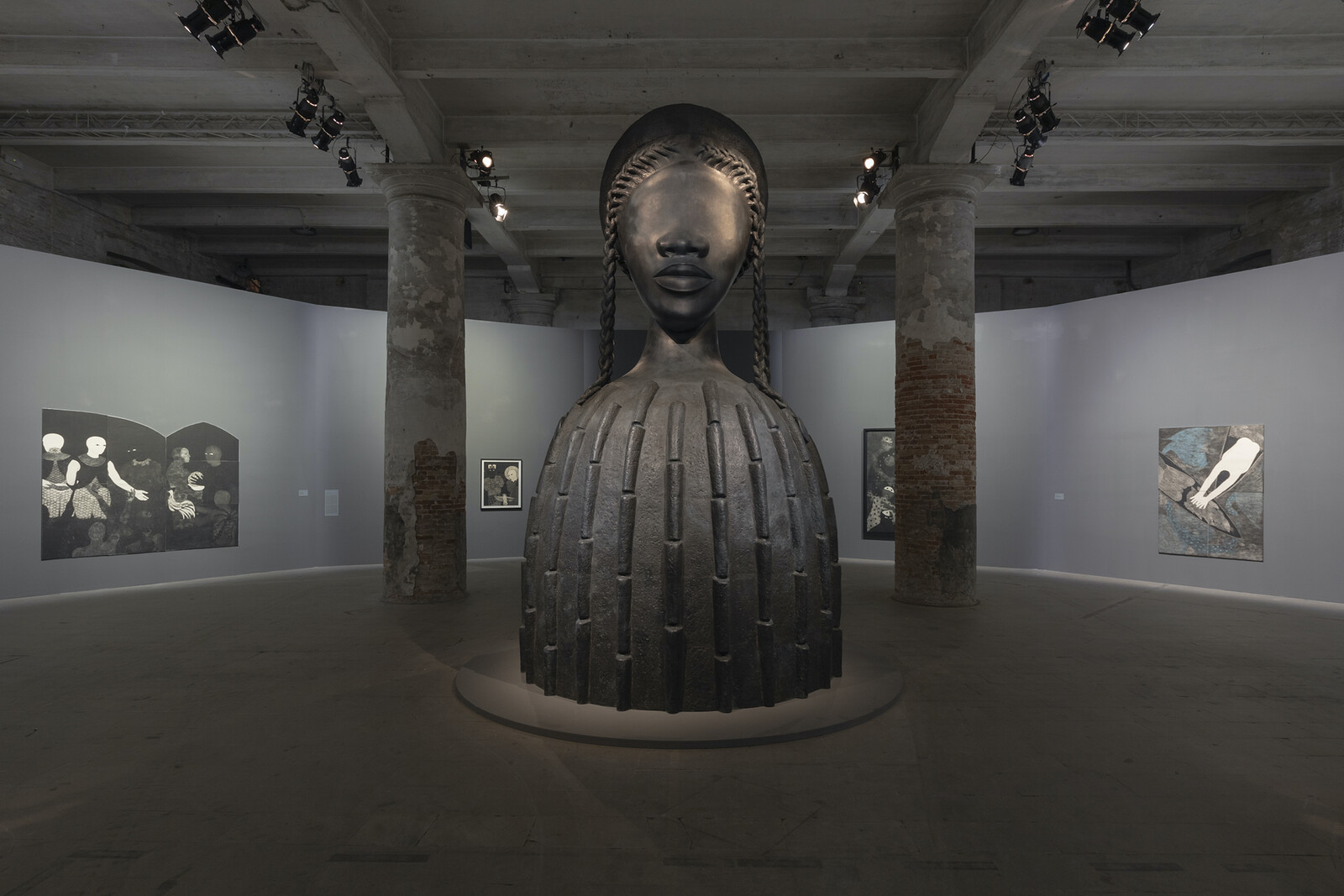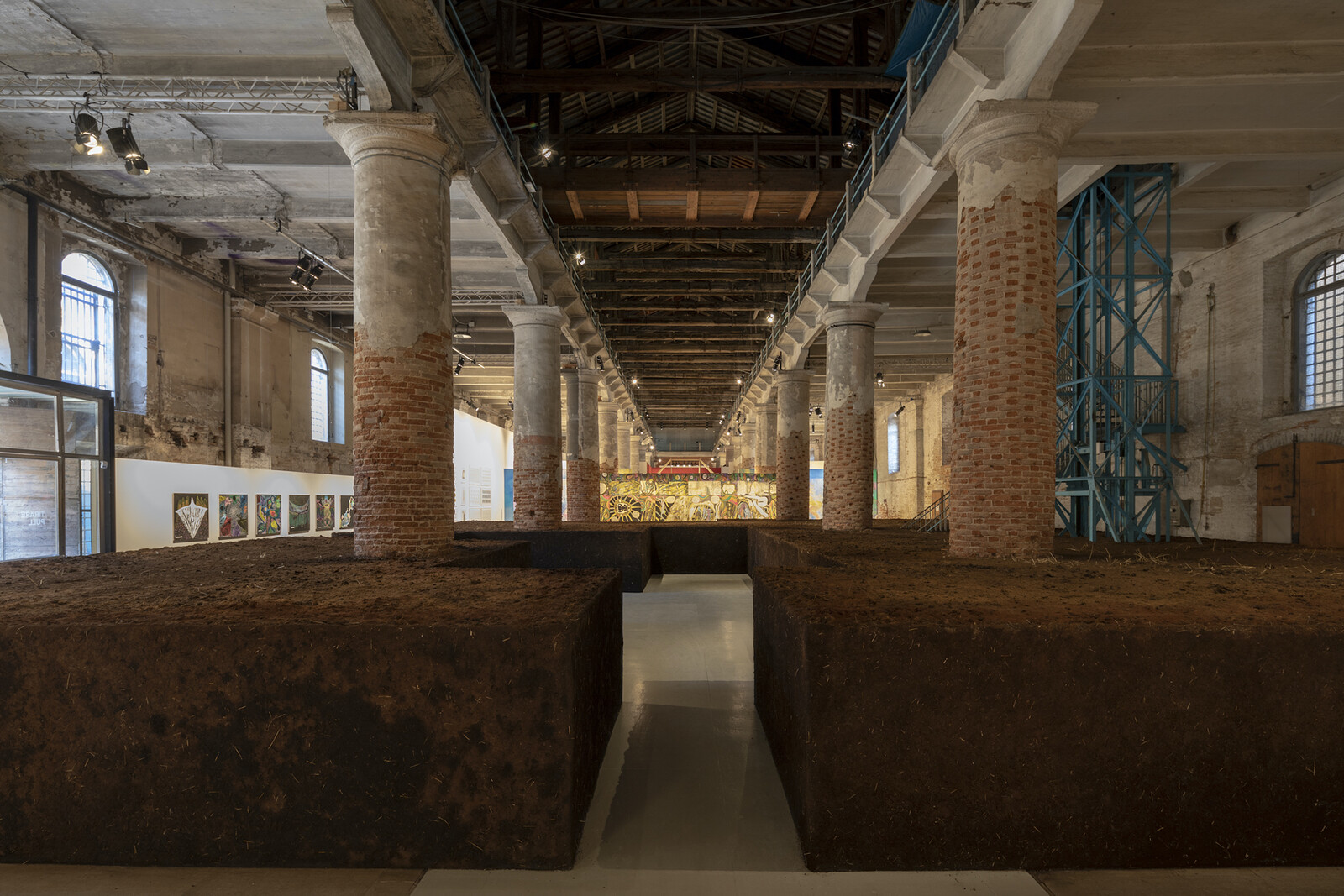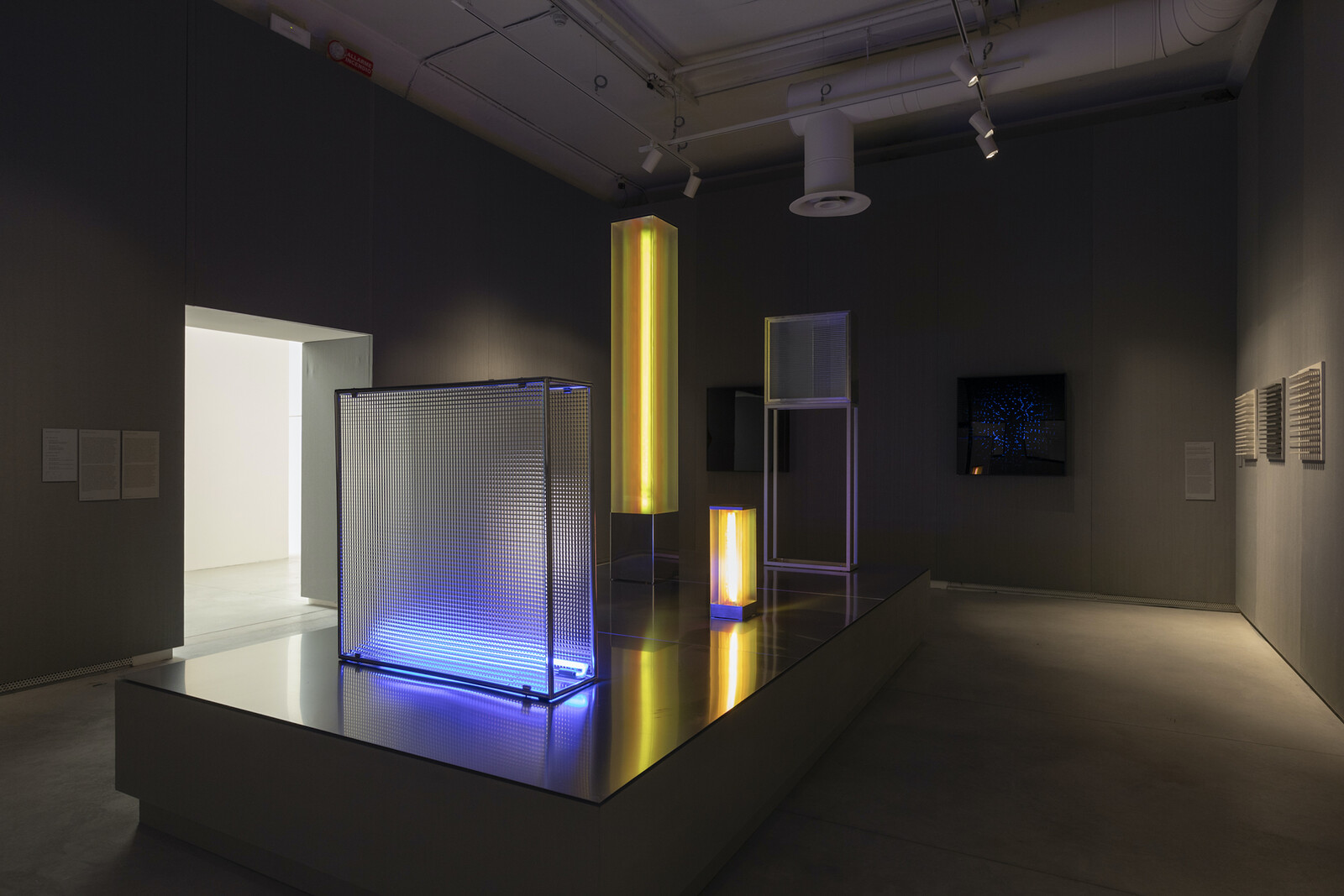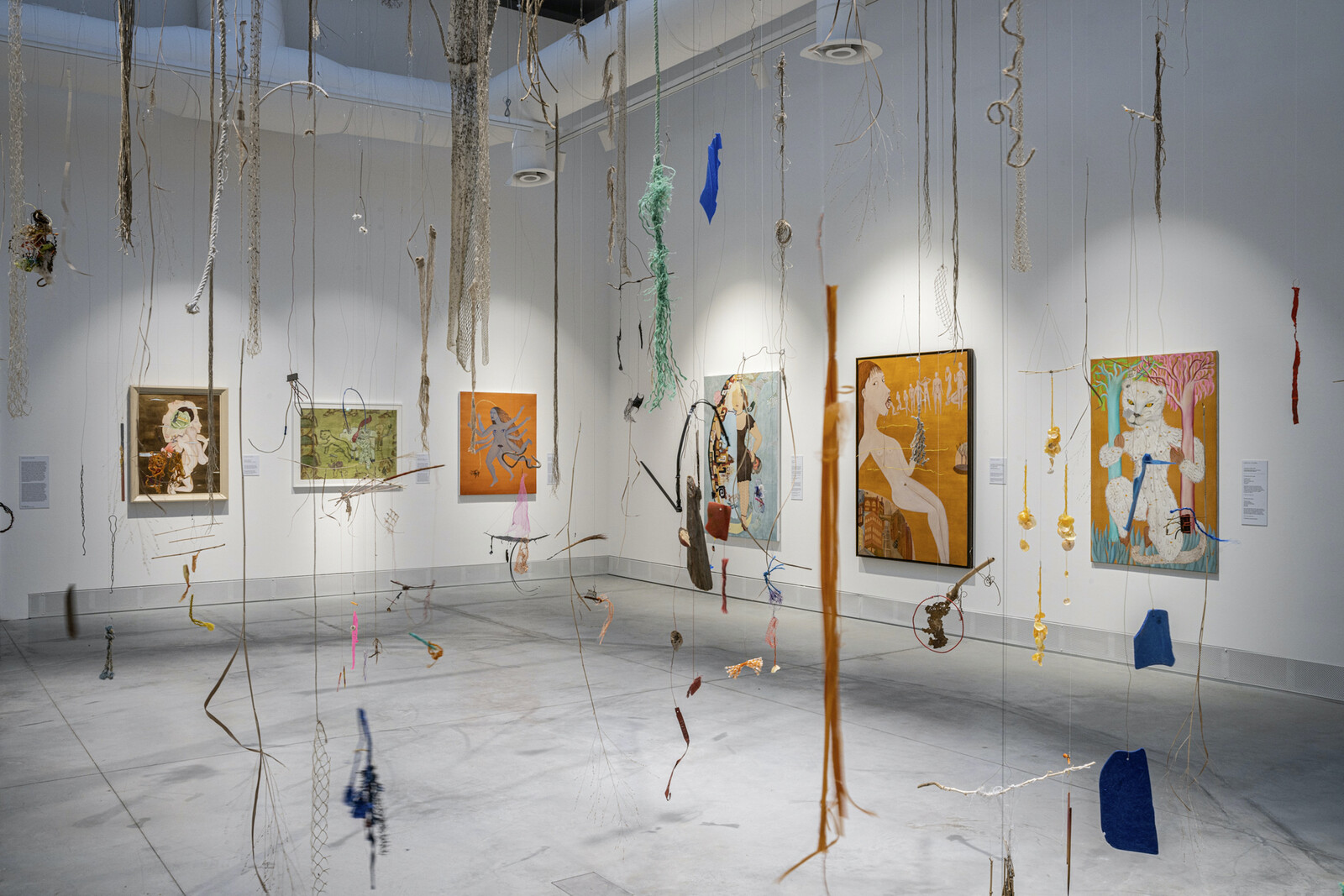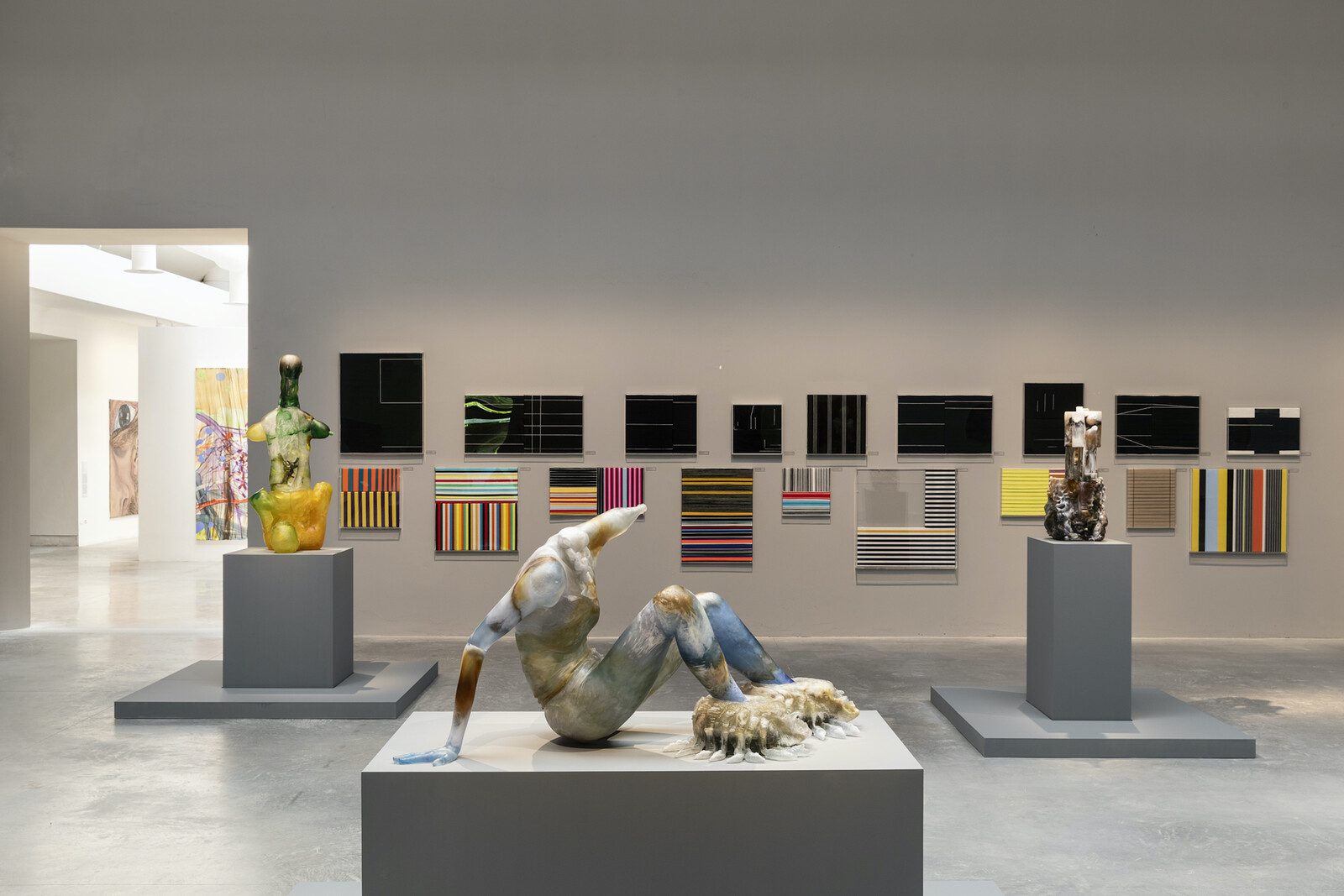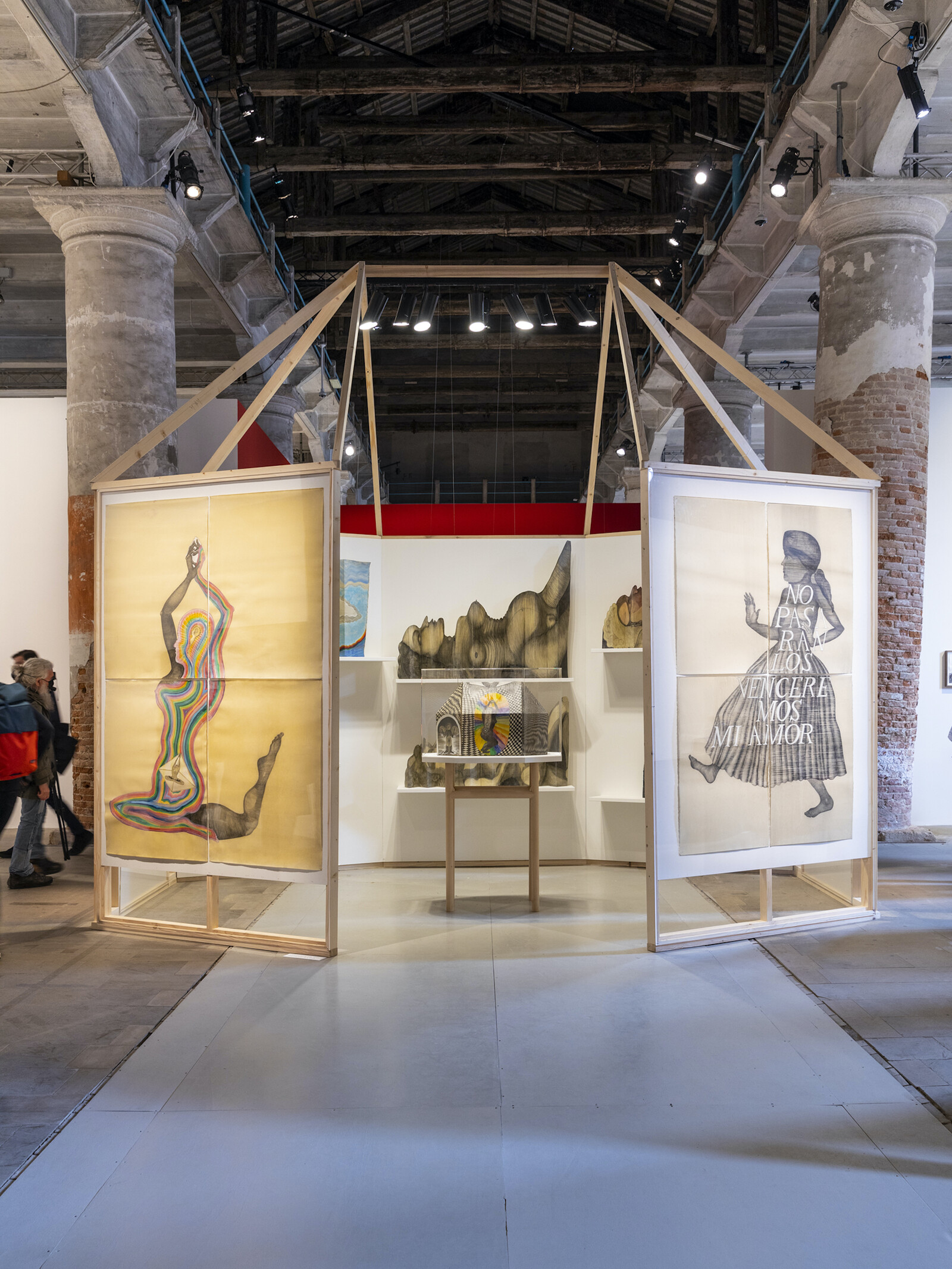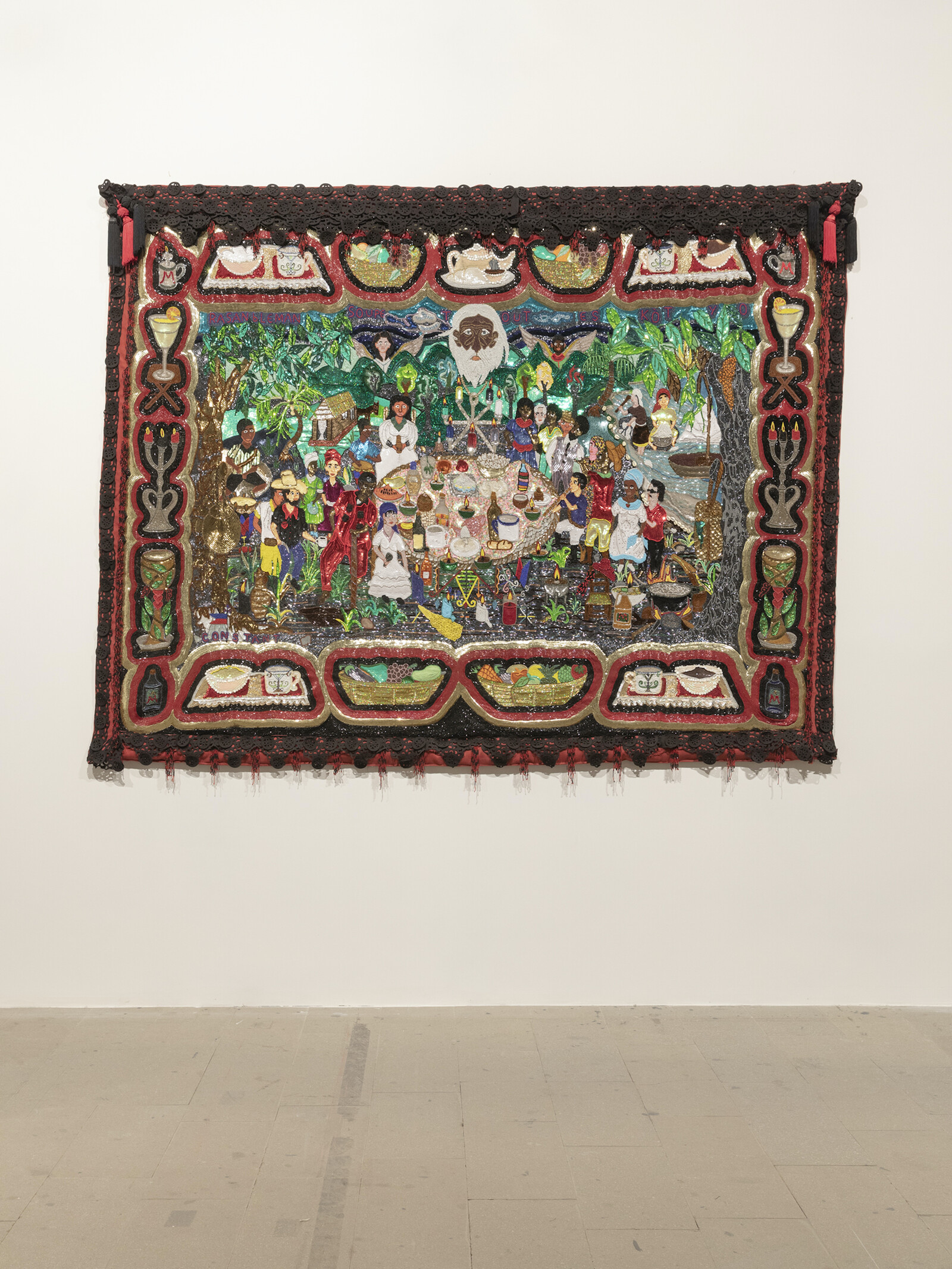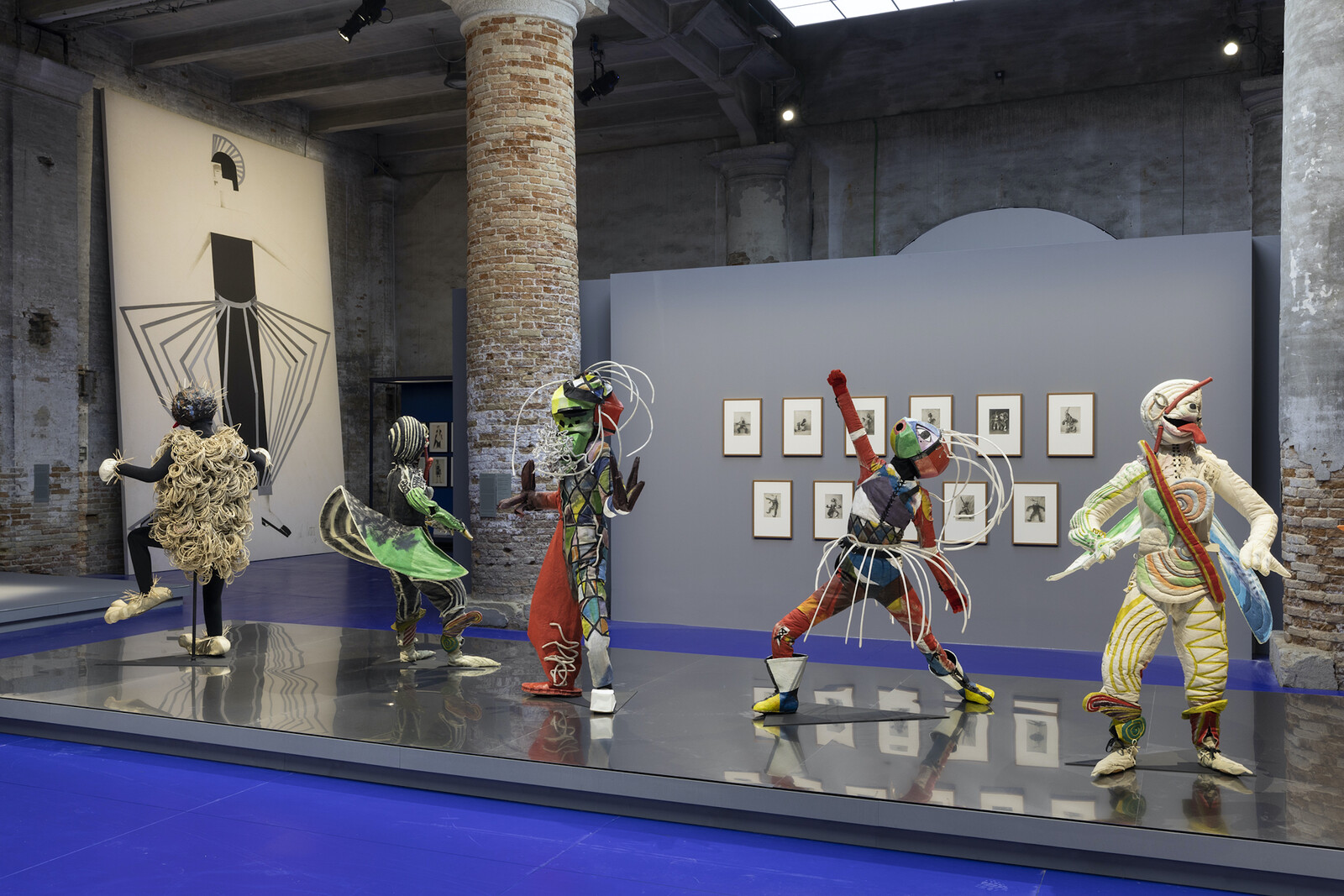April 23–November 27, 2022
How to make an exhibition about technologies of gender in the year 2022? About bodies that are symbiotic and prosthetic and in solidarity—an extension of ourselves into other receiving forms, whether animal, vegetal, machinic, spirit, land, human, or otherwise—and about an ecosystem in which the body is seen as a vessel of ancestral and speculative relations and active possibilities? That is, at once mutable, vulnerable, hybrid, Indigenous or diasporic, human or non, but ever transforming and telegrammic? Real queries, I know, but stay with me. We were all once stardust, remember.
Take These Eyes
Djamila Ribeiro has written about understanding “the gender category” from non-Eurocentric sources, taking, for example, the female orixás deities in African-origin religions including Candomblé and Umbanda. This is feminist discourse by other “geographies of reason,” with women of care, women of cult, mythical female ancestors, and African diaspora witches who are, she writes, “the antithesis of any denial of behavioral, political, ethical transcendence that women may represent.” Ribeiro notes, precisely: “From them it is possible to think of a practice that transforms the colonial relations present today.”1 Her words surfaced in my mind as soon as I entered the opening rotunda of Cecilia Alemani’s exhibition in the Arsenale, that colonial-era set piece of empire and fleet-building, rippling out across oceans and seas and bodies and centuries. Here, Simone Leigh’s sixteen-foot-tall bronze bust, Brick House (2019), centered and raised the room, all colossal sentinel sans eyes. Her architectonic skirt both shelter and body, her titular Commodores lyric at once celebration and song, her origins in the West African Batammaliba and Mousgoum cultures and aesthetic signatures of building. All-seeing by unseeing, I thought, then looked around.
Those missing eyes were to be found, myriad and open wide, on the curved walls all around, in the Cuban printmaker Belkis Ayón’s dazzlingly spectral collographs of the mythic princess Sikán. The princess is the only female figure of Abakuá, an Afro-Cuban fraternal society from Nigeria that traveled the Black Atlantic with its enslaved peoples to Cuba and Haiti. The prints are graphic and arresting, full of a ghostly Black futurity. In a reverse of Leigh’s sculpture, Ayón’s Sikán has eyes but no other facial features, her body hypnotically surfaced with scales. Of her silenced central figure, no fissure of mouth crossing the many depictions of her staring face, Ayón once noted: “There are burdens with which you cannot live or drag along,” she said. “Perhaps that is what my work is about—that after so many years, I realize the disquiet.”2
Ayón died in 1999, at 32, by suicide. She had previously exhibited at the Venice Biennale in 1993, with works that she and her father transported to the airport in Havana by bicycle during Cuba’s deep depression of the early ’90s (mostly due to subsidies lost from the dissolution of the Soviet Union). One series of works, La consagración (1991), is exhibited here only as photocopies. Confused, I looked for a wall label to explain. It did. “This key example of the artist’s work is part of the collection of the State Russian Museum in Saint Petersburg. Because of Russia’s invasion of Ukraine in February 2022, it was impossible to show the original work here.” I wondered how Ayón’s work found its way into the Russian State collection—shared ideologies and open borders, I suppose—and I wondered when it would once again make its way out.
Both Leigh’s and Ayón’s works, though, and their expertly constellated exchange, suggest a fluidity of form and cosmologies, an entanglement of diasporic relations: human and nonhuman, from artwork to artwork, form and field, time and space, face to face. All predict Alemani’s larger exhibition, with its bodies—mostly manifested in painting and sculpture, textile, and ceramics—in constant states of transformation and interchange. The forms become human, then vegetal, then animal, then egg, then machine, then land, then language, then back again. Nature only exists if you consider yourself outside of it, is a line that often bruises my thoughts. It evokes Indigenous perspectivism: To me, I am human and the palm giving me shade is a tree. But the palm, leaning thoughtfully, might think of itself as human and me as bark, as leaves. This fluidity of POV extends to our bodies as well, which might likewise translate between forms we often narrowly conceive of as human and real. In “The Milk of Dreams,” such fluidity of material form and epistemological thought, and the technologies of their transformations, is milked for all it’s got. Am I hooked? Am I drinking it? Yes and no and yes again.
Milk
In the Arsenale, as well as in the exhibition’s Central Pavilion, eyes are everywhere: a trope, a grammar, less windows into souls than pale screens for projections. Not transparency but some opal opacity. Each dark iris slicing through some milky pool, wet or dry. Each essay of eyes, unblinking, wide, stopped me. Josephine Baker’s huge then cross-eyed, clowning, in a concise video of her tasselled dancing (Dans Revue des Folies Bergère, danse avec plumes…, 1925); Cecilia Vicuña’s cascading across her lucid paintings (notably Bendigame Mamita, 1977); Ulla Wiggen’s enormous and total, ripped and enlarged from the field of the face, her shaped canvases all iris (Iris XVIII Line, 2021); then Josefa Tolra’s, Lois Malou Jones’s, Rosana Paulino’s, then Leigh’s again, out in the Giardini gardens, still missing.
On the posters advertising “The Milk of Dreams” around the city, these eyes suggest a kind of lucid dreaming, that is, Surrealism, its aesthetic equivalent (sometimes). What about Surrealism? Alemani gleaned her title from Leonora Carrington’s book of children’s stories, in which ears might become wings, bodies all metamorphosis. The surrealists’ painterly investiture in literature, in narrated worlds in which simile and metaphor each play their dreamy roles of analogy and avatar, is less debt than treasure chest, all loot all the time. Meanwhile, their dream debt to the somnambulant—the way in which they invest the vertical body with the dream logic and violence of sleep, of the horizontal—is both prosaic and poetics. We read the sentence but we feel the poetry pulsing like some engine or metronome through it. Why am I using the language of economics? Well. Car parts, et cetera.
Alemani includes five historical “time capsules,” discretely bounded miniature group shows set off from the flow of the main exhibition. Each is quietly astonishing, focusing on gender, technology, concrete poetry, narrative and storytelling, and, yes, surrealism. This latter capsule was lucidly placed in that small underground room at the back of the Central Pavilion; one can enter from two sides, a kind of palindrome of entrances for our salon-like Ouroboros. The room’s thick pile of mineral-colored carpet curved up the walls: no hard edges except the vast glass vitrines, either museological choice or insurance requirement.
Surrealism is often reduced to its fetish for the unconscious, an externalization of a specific interiority built by exemplary privileges: white, male, patrician, Western European, mommy issues. But this is Surrealism in its most canonized colonial-patriarchal guise. It is the Surrealism of permanent collections. Alemani shows how surrealistic activity was employed by artists and writers—often women, people of color, nonbinary, diasporic, or colonized subjects—as a form of speculation, political fabulation, nonhuman entanglement, ludic justice. Surrealism used to imagine and represent worlds whose source sprang from elsewhere than the tinny refrains of certain childhood trauma and its well-mapped territorializations.
In this exhibition, Surrealism’s canon of white men was ignored, finally, for works by Algerian painter Baya Mahieddine, photographer Ida Kar, transdisciplinary artists like Alice Rahon and Josephine Baker, Surrealist stalwarts like Leonor Fini and Meret Oppenheim, and poet-publisher-thinkers like Suzanne and Aimé Césaire. Artists one would not think of as Surrealists somehow exemplified its narcotic, psychic magic: see Augusta Savage’s small bronze harp-like sculpture made of singing bodies, their mouths arched and open in the nestlike ripples of their collective instrument. The original sixteen-foot-tall Harp, called Lift Every Voice and Sing, after the titular Black spiritual, was commissioned for the New York World’s Fair in 1939, then destroyed.
Axes
The Indigenous thinker and elder Davi Kopenawa notes of white people: “They sleep without dreams, like axes abandoned on a house’s floor. Meanwhile, in the silence of the forest, we shamans drink the powder of the yãkoana trees, which is the xapiri spirits’ food. Then they take our image into the time of dream. This is why we can hear their songs and contemplate their presentation dances during our sleep. This is our school to really know things.”3 In an exhibition devoted to material metamorphoses and earthly entanglements, it is not surprising to see, in 2022, an emphasis on Indigenous practices, as well as works by non-Indigenous artists invested in ancestral epistemologies. Amazonian and Sámi artists are well represented, as are many incredible artists from the Caribbean and the Americas, whose works draw on certain pre-Columbian iconographies: the wonderful Myrlande Constant of Haiti and her virtuosic glass-beaded Vodou flags of sirens, Chilean Sandra Vásquez de la Horra’s incalculably moving accordion-folded drawings of mythic female figures sealed with beeswax, and Mexican painter Roberto Gil de Montes’s admixture of Mexican modernism and Huichol iconography (his Los poetas en el mar, from 2021, took me home).
The late Macuxi artist, curator, and activist Jaider Esbell, who died by suicide last year, is represented by a series of six paintings, his electric brushwork of frogs, cows, and other visionary animal spirits, glowing, irradiating, from black fields. His loss is felt here, as well as in Delcy Morelos’s installation that fills the same room: Earthly Paradise (2022), a field of earth the height of a child, its scent deep and dank and wonderful, tangible even through my mask. Raised in Indigenous Embera territory, and educated in Cartagena, Morelos’s monumental earthen works—inspired by her study of Amazonian Witoto thought, evoking de Maria—suggest both end, here, and origin.
How these brilliant, complicated cosmological works float and figure among the more familiar modernist and contemporary art practices from the US and Europe is an issue that Alemani leaves unresolved, if not ignored. Indeed, the show’s contextualizing of bodily metamorphosis, hybridity, and human-nonhuman relations with the earth in their most exclusively Eurocentric guises—Surrealism, Donna Haraway, et cetera—is disappointing. The historical capsules, though excellent, underline this Eurocentric historiography, in a sense, even if the curatorial selection of artists in the larger exhibition expertly rebuts it.
Ones and Zeros
In Yanomami cosmology, xapiri are auxiliary spirits of the shaman. As Ailton Krenak has written: “They can be a hummingbird, a tapir, a jaguar, a monkey, a flower, a plant, a liana vine—all of them are people, and they interact with the shaman. These beings make exchanges, alliances, they invent and cross worlds; and, while they are in movement, they move everything around them.”4 Such is the case with the many artworks on view in which trees sprout from shoulders or legs become roots, torsos end in fins or curl into eggs, or arms become serpents flicking forked tongues into—what?—shadows.
Such hybridity, though, can be prosthetic as well. Technologies—of gender, apparatus, machine, performance, colonialism, expropriation, racial capitalism, language, painting—are everywhere, not often in the expected guises. There is little video, for example. Not much photography. Have you ever seen so much painting? everyone asked. Yet the rooms devoted to technology or its early aesthetic forms are brilliant: from the “Seduction of the Cyborg” capsule, with its eighties-era totemlike figures by Liliane Lijn, the thirties-era aluminum reliefs of Regina Cassolo Bracchi, and the bodily anagrams of Kiki Kogelnik, all less self-blazoning than self-creating, to works by Lucia Di Luciano, a founder of Gruppo 63, whose matrices of black-and-white paintings on Masonite kept my eyes glued to them. Like weaving, they suggest the warp and weft of labor, crossover, rigor, architecture, a suffocating psychological interior and architectonic exterior both.
A more elusive thread, which I will try to pull as tightly here as I can, links a reprise of finish fetish and its American West Coast ancestry to newer offspring. Monira Al Qadiri’s fantastic, nearly iridescent rotating sculptures; Teresa Solar’s enormous crab claws, gleaming like cars at golden hour; Christina Quarles’s stunning suite of paintings of fluorescently attenuated figures, her neon brushwork nervy and thick or latex-tight and almost airbrushed; Tishan Hsu, my first and only sculpture professor, whose unsettling series of sci-fi reliefs, at once screens and skins, are phenomenological and suffocating in equal measure. It all reminded me of a kind of California dream—not of my Southern California childhood but of those that preceded mine, for I was not then alive, as well as those that have now come after.
Consider, too, Alemani’s gift for technically brilliant opening lines. After the Arsenale’s expert pairing of Leigh/Ayón, in the Giardini Andra Ursuţa’s luminous hybrid vessels, cast of her own body, all pastel fetish and gorgeous fragmented horror, some mystic self-blazoning for the twenty-first century, are surrounded by walls of Rosemarie Trockel’s knitted pictures and wool works with titles lifted from the likes of Duras (Destroy, She Said, 2007). Women’s work, indeed.
Signs
Simultaneously precise and overwhelmingly opaque, “The Milk of Dreams” can feel as suffocating and surreal as a dream that does not stop. Too much, one yells, tossing—and by one, I mean me, and everyone else. Not a real complaint. I’ll be thinking of this show for a long time. Much has been made of the number of women-identifying artists, and the small percentage of men. I didn’t miss them. My fear, though, is that in two years the market—its neocolonial-corporate oligarchs, their fortunes in tech or bombs or gas and oil or real estate or indentured masses on temporary-to-nothing contracts, and the racial-patriarchal capitalism in which they all continue to operate—will reassert itself. “The Milk of Dreams” will become known as “the women’s show” or “the show of Indigenous cosmologies and gendered technologies” (it already is). It will become a kind of dream—that form we are normalized to forget—taught by feminist professors to select grad students, rediscovered by scholars every couple of decades, like the pavilion curated by Annemarie Sauzeau in homage to Carla Lonzi at the 1993 Venice Biennale, which I discovered in only the third decade of my life, while Hans Haacke’s German Pavilion of the same year has been part of every curriculum I’ve been taught since puberty.
Indeed, each morning of my past week in Venice, as I walked a set of narrow pastel streets and chalky bridges to the Arsenale and Giardini, I kept passing signs: STERLING RUBY, one body-sized poster read. ANSELM KEIFER, a cathedral-sized banner, blanketing the edifice of an actual cathedral, announced. I walked faster. To ignore such signs—this is more than denial, I think. Years ago, in a fit of pique after seeing an artist talk by Ruby in Geneva, in which he casually assigned his quick success to all the humble women artists who had taught him, I wrote a poem which I titled “It’s Hard for a Man (Making Women’s Work) in the World.” Is it, though? Not really.
Ghost Ships (A Coda)
A week ago, on the dawn train from Zurich to Venice, watching the sun run like an egg over the Alps, and the lakes turn into slippery, silvering mirrors, I remembered watching another sunrise, years ago, in the city I was traveling to. Was it a dream? Yes and no. I was sitting on the edge of the lagoon in front of the Giardini after a party, my cold legs dangling over oily waters. The sky was blue-black and then lighter blue, like a bruise. Pink seeped out into a thin blood sentence at the horizon. In front of me rose a huge black yacht, parked in the narrow canal to shallowly challenge the colonnaded pavilions of nation-states to a death match. More death star than the stardust we are made from. An artist pointed out the yacht’s enormous dark windows to me, which he said repelled photographs: any picture you took would come out blank; like some Stalin-era photographic disappearance, I thought. This artist’s own country had been invaded, terrorized, and occupied by the same regime that made this yacht and its oligarch and his parking spot possible. That yacht of disappearing images is now, a decade later, in international waters evading sanctions, the same narcotic, telegrammic, violent sun bleaching its black decks. Its owner has given up his football team, fled east, and was recently poisoned trying to negotiate peace between his murderous regime and its present target, or so the gossip reads. So real, surreal.
There is no way to balance wars with exhibitions, and yet—art emerges regularly from their valences of violence. The key perhaps is not to ignore it, not to render it “unspeakable,” nor to cater to those who would fund it. They depend on our silence, and our ready acceptance of their mediocre artists-as-investments. For the backers of art and the backers of war are often one and the same. War against peoples and war against the earth—also one and the same, as the exemplary Sámi Pavilion, and its Indigenous artists, would and did declaim in its opening days. “What happens to the land, happens to the people,” as their maxim goes. Pauliina Feodoroff’s Matriarchy performance, in which she and other Sámi women laconically circled the rectangular glass Nordic Pavilion offering small objects (a feather, a knife, a set of bells) to the crowd of spectators to see—with our own eyes—underlined this point, somehow. Look at this, and this, and this, they seemed to suggest, quietly, virtuosically, ludically. And we did.
Djamila Taís Ribeiro dos Santos, “Brazilian Black Feminism: Undoing Racial Democracy Towards a World Ethic with Orixás,” in Stronger Than Bone, eds. Defne Ayas, Natasha Ginwala, and Jill Winder (Gwangju/Berlin: Gwangju Biennale Foundation and Archive Books, 2021).
Sandra E. Garcia, “Overlooked No More: Belkis Ayón,” the New York Times (April 2, 2018): https://www.nytimes.com/2018/03/08/obituaries/overlooked-belkis-ayon.html.
Davi Kopenawa and Bruce Albert, The Falling Sky: Words of a Yanomami Shaman, trans. Nicholas Elliott and Alison Dundy (Cambridge: Harvard University Press, 2013), 24.
Ailton Krenak and Maurício Meirelles, “Our Worlds are at War” in e-flux journal, Issue 110 (June 2020): https://www.e-flux.com/journal/110/335038/our-worlds-are-at-war.
